In several earlier posts I have mentioned Isabella Bird, who visited Taiping in 1879. In this post I will describe in somewhat more detail the visit of this intrepid English traveller.
Isabella Bird was born in 1831. Already at a young age she was bitten by the travel bug. During her travels she wrote letters to her sister Henrietta in Edinburgh and these letters have been published in a number of books.
In 1878 she visits Japan (resulting in her book Unbeaten Tracks in Japan) and on her way back to England she spends a few weeks in Hong Kong. On 10 January 1879 she has a lunch with Chief Justice Snowden. In a letter to her sister she writes :
” .. he urges me to go to Malacca on my way home. I had never dreamed of the “Golden Chersonese;” but I am much inspired by his descriptions of the neighborhood of the Equator, and as he has lent me Newbold’s Malacca for the voyage, and has given me letters to the Governor and Colonial Secretary of the Straits Settlements, you will next hear from me from Singapore! “
On 18 January she arrives in Singapore where she is the guest of Cecil Smith, the Colonial Secretary of the Straits Settlements. She writes:
“I wonder how this unexpected and hastily planned expedition into the Malay States will turn out? It is so unlikely that the different arrangements will fit in. It seemed an event in the dim future; but yesterday my host sent up a “chit” from his office to say that a Chinese steamer is to sail for Malacca in a day or two, and would I like to go?”
She has only 5 minutes to decide. And of course she goes, always eager to escape from civilisation 😉 .
The two quotes above are from her book The Golden Chersonese and the Way Thither , published in 1883. Left the original edition, right my own copy, a reprint from 2000. You can also read it online or download it to your tablet.
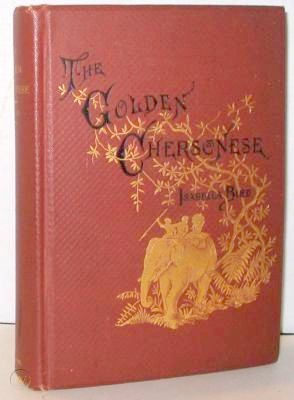
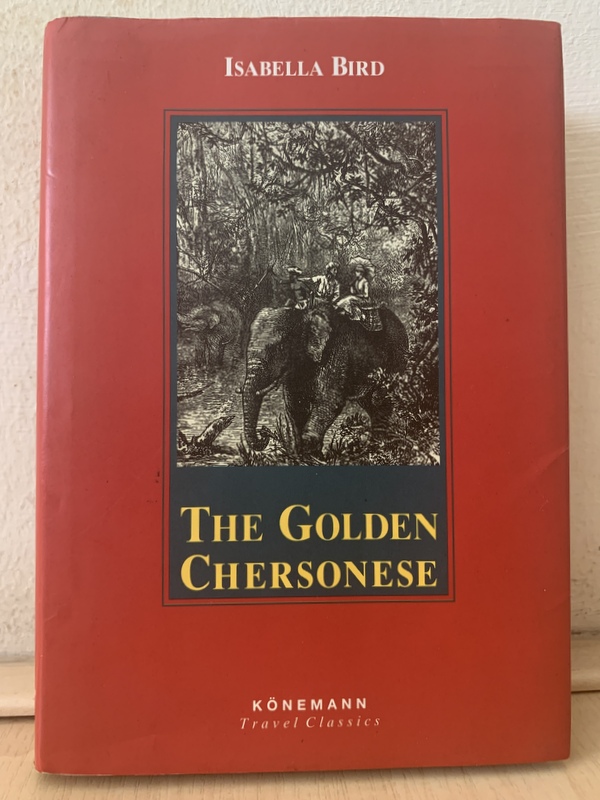
The Golden Chersonese is the ancient name for the Malay Peninsula. The book contains 23 letters, in the first seven chapters/letters she describes her visits to Hong Kong, Canton, Saigon and Singapore (the Way Thither).
I have read her book with admiration and fascination. What a remarkable lady.
Before I write about her travels, first a short description of the (political) situation in the Malay Peninsula during the seventies of the 19th century.
There were the Straits Settlements, a British Crown Colony consisting of Penang, Melaka ,Singapore ( and after 1874 the Dindings), and many independent Malay states. Several of them were in turmoil, for a variety of reasons, the Larut wars (1861-1874) in Perak , the Klang War (1867-1874) in Selangor, a Civil War (1873) in Sungei Ujong {present day Seremban). The result of the Pangkor Treaty (1874) was that Perak accepted a British Resident and soon Selangor and Sungei Ujong followed. The first Resident of Perak , J.W.W Birch, was murdered in November 1875, resulting in the Perak War (1875-1875) . Turbulent times.
And to give you an impression how unknown the peninsula was in those days, from 1875 until 1882 D.D. Daly, Superintendent of Public Works and Surveys, Selangor, surveyed the Malay peninsula with this map as one of the results. His report, presented to the Royal Geographic Society in 1882, is very readable.
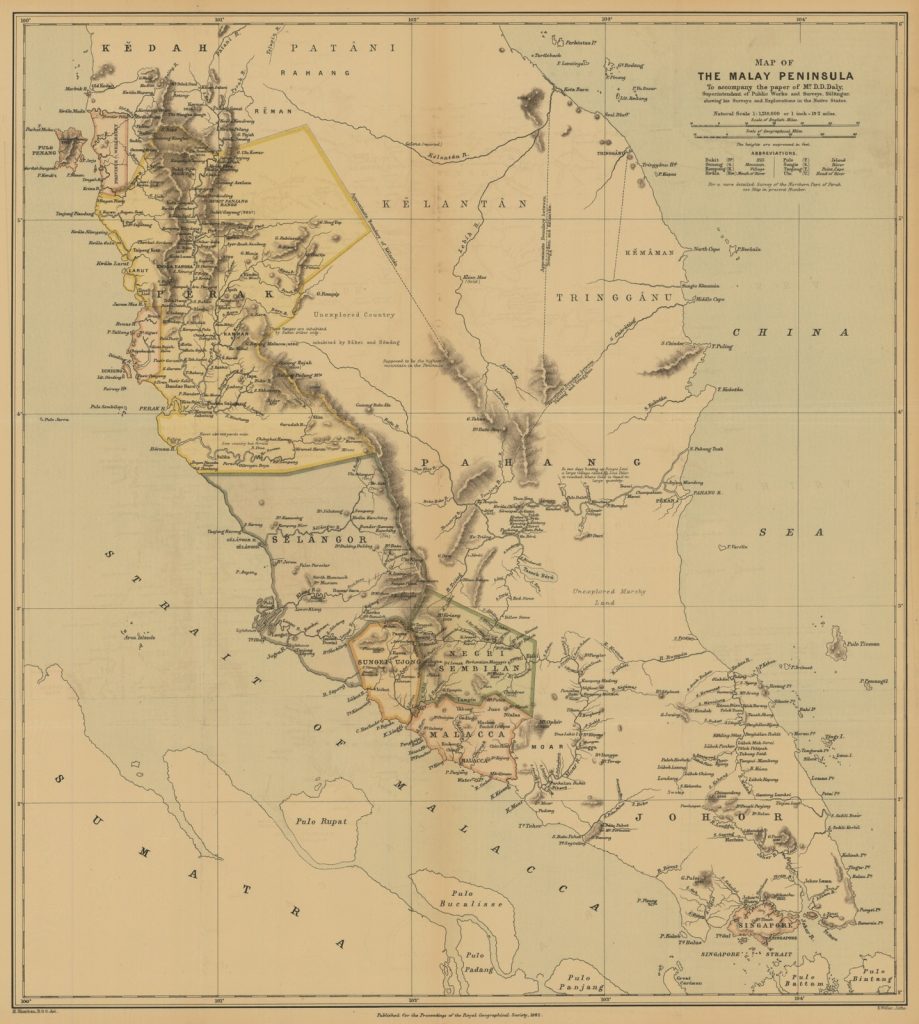
On 19 January Isabella Bird leaves Singapore with the SS Rainbow. A small screw steamer with an interesting history. First owned by Rajah Brooke of Sarawak, later sold to the Government of the Straits Settlements and finally to Chinese merchants. Overloaded with about 150 people, she being the only “white man and Christian”, she lands the next day in Melaka “.. after a most pleasant voyage in a steamer one would have thought too bad to voyage in”.
Melaka was part of the Straits Settlement, a sleepy town ” .. the narrow stream and bridge, and the quaint red-tiled roofs of the town, is very charming and harmonious; yet I often think, if these dreamy days went on into months, that I should welcome an earthquake shock, or tornado .. ” She stays in the Stadthuys.
From Melaka she makes an adventurous trip to Sg Ujong, first with a steam launch to the mouth of the Linggi river, then in a perahu. Her description in letter XI is so fascinating that, many years ago, I followed by car, as close as possible, the Linggi river with a friend, from the river mouth to Seremban: Linggi adventure, 15-7-2008. Here I am standing near the river, no crocodiles or tigers anymore.
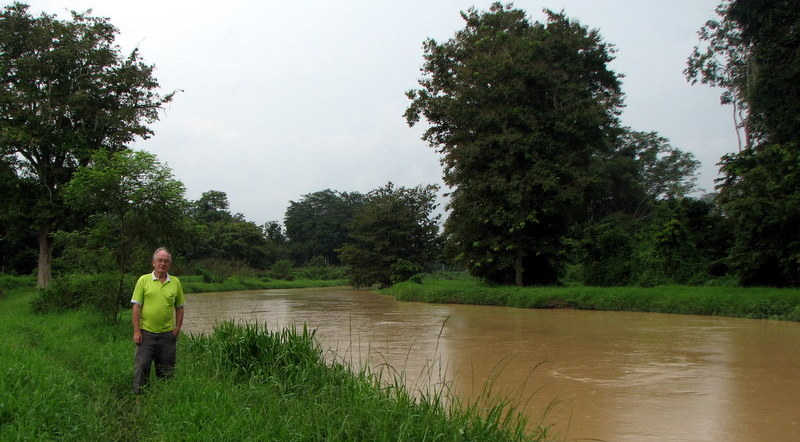
Isabella’s next destination is Selangor. On 1 February she arrives in Klang (“a most mistriven, decayed, dejected, miserable-looking place “). She stays in the Residency, makes a trip to Jugra to visit the Sultan and is clearly less happy then in Sg Ujong.
A few days later she sails to Penang aboard the Abdulsamad, the yacht of the Sultan, visiting Kuala Selangor and Sabba (Sabak Bernam) on the Bernam river on their way. She spends one night in the Hotel de l’Europe (nowadays part of the E&O hotel) and 10 February she crosses over to Province Wellesley, where in the evening the steamer Kinta arrives with W. E. Maxwell, the Assistant Resident of Perak. In his company two nice Malay boys, the sons of the exiled Sultan Abdullah who will go to Melaka for their education. This is the Kinta.

They leave at night and the next morning at 7 am they reach Teluk Kertang, in those days the main port of Taiping , (“.. with a pier, a long shed, two or three huts, and some officialism, white and partly white, all in a “dismal swamp”) Nowadays Teluk Kertang is a quiet kampong with several shipyards and charcoal kilns.
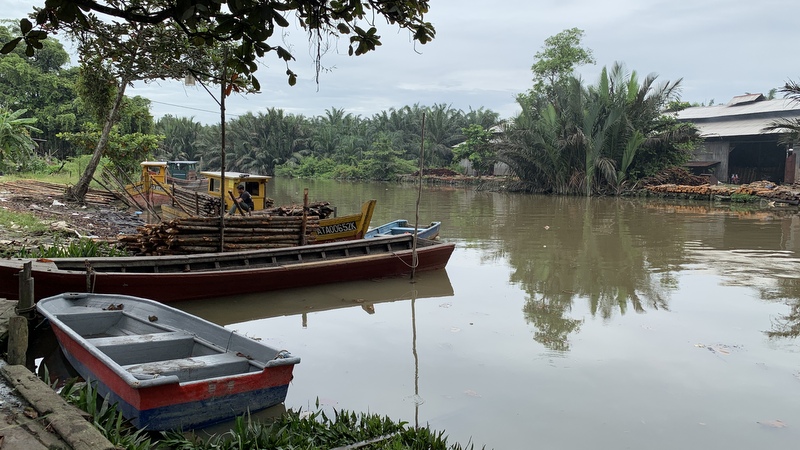
In gharries (horse-drawn carriages) they drive to the residency. In Permatang they pass “ … two very large two-storied Malay houses in some disrepair, in which the wife of the banished Mĕntri of Larut lives, with a number of slaves. ” That must have been Kota Ngah Ibrahim. Of course it looks very different now.
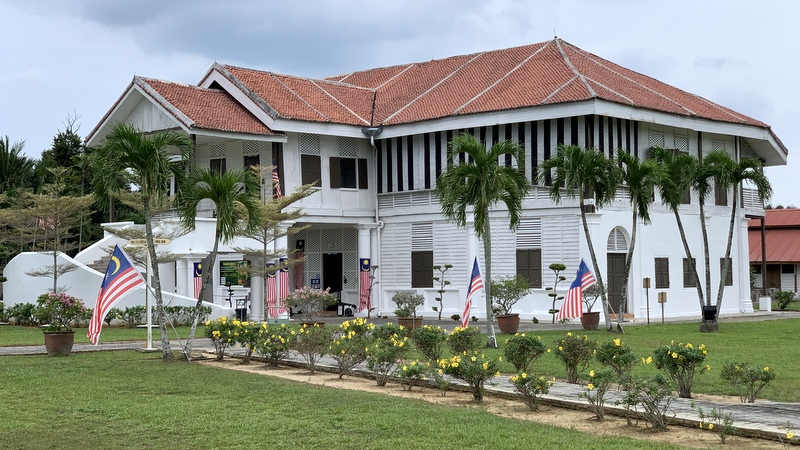
It was here that in 1876 the trial of Birch’s murderers took place, resulting in the conviction and hanging of two Malay noblemen and the banishment of Sultan Abdullah and Ngah Ibrahim to the Seychelles. The Kota is now a museum, on the first floor you can see scenes of the trial.


They continue to Taiping: “From this point we drove along an excellent road toward the mountains …. and near noon entered this important Chinese town, with a street about a mile long, with large bazaars and shops making a fine appearance, … and on the top of a steep, isolated terraced hill, the British Residency“. The green line in this Google Earth screenshot, is probably how she went from Teluk Kertang to the Residency.
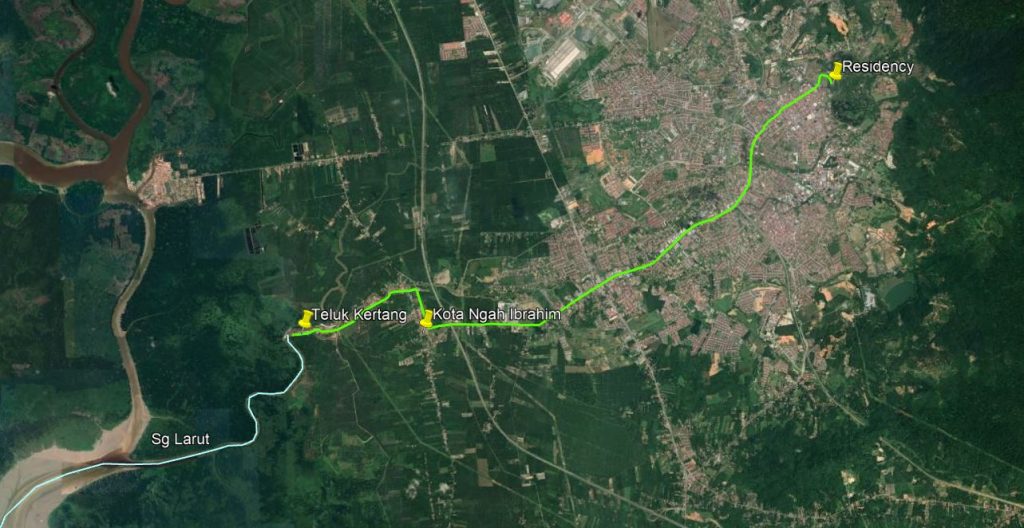
Maxwell resided in what nowadays is the District Officer’s Residence, originally built by Captain Speedy.
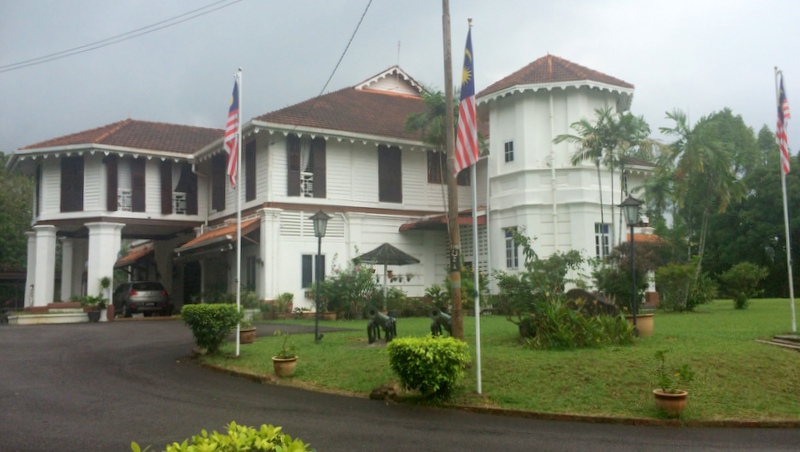
It must have looked very different when Isabella Bird stayed there. In her description: “The Residency is large and lofty, and thoroughly draughty, a high commendation so near the equator. It consists of a room about thirty feet wide by sixty long, and about twenty feet high at its highest part, open at both ends, the front end a great bow window without glass opening on an immense veranda. “
She stays a couple of days in the Residency and enjoys it very much. “The house on my side has a magnificent view of the beautiful Hijan hills, down which a waterfall tumbles in a broad sheet of foam only half a mile off, and which breed a rampageous fresh breeze for a great part of the day”. Here is the waterfall, a bit further away than she thought, one and a half mile away from the Residency.
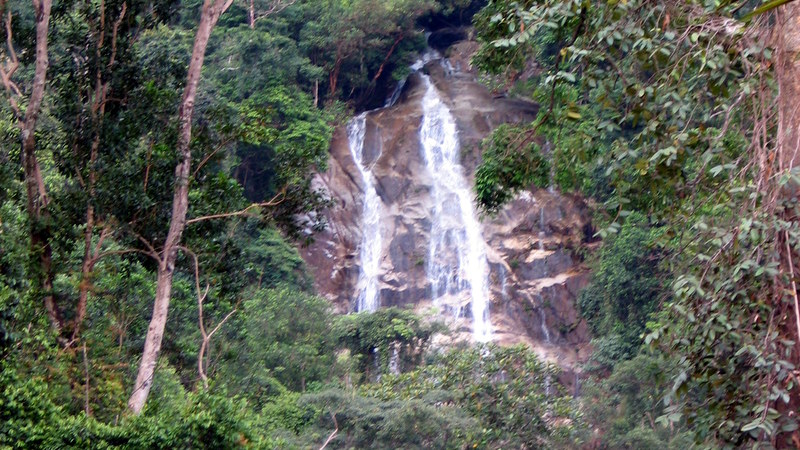
She continues her description: “The front veranda looks down on Taipeng and other Chinese villages, on neat and prolific Chinese vegetable gardens, on pits, formerly tin mines, now full of muddy, stagnant water, on narrow, muddy rivulets bearing the wash of the tin mines to the Larut river”. Taiping as seen from the Residency may have looked like this. One year later, in 1880, the town was destroyed by fire and rebuilt in brick.

The food is simple and Maxwell is working all the time “There are two simple meals daily, with tea and bananas at 7 A.M., and afternoon tea at 5 P.M. Mr. Maxwell is most abstemious, and is energetically at work from an early hour in the morning ”
She is alone a lot , visits the town and enjoys the company of the two boys. “Those boys of Sultan Abdullah’s are the most amusing children I ever saw. They are nine and twelve years old, with monkey-like, irrepressible faces. They have no ballast. They talk ceaselessly, and are very playful and witty, but though a large sum is being paid for their education at Malacca, they speak atrocious “pidjun,” and never use Malayan, in my hearing at least”. Interesting detail, the two boys, Raja Chulan and Rajah Ngah Mansur were later involved in the creation of the Perak State Anthem.
During her stay she also visits a tin mine in Kamunting. She gives a detailed description of how a mine is working and is treated well by the Chinese owner of the mine who “.. had conveyed champagne, sherry, and bitter beer! His look of incredulity when we said that we preferred tea, was most amusing; but on our persisting, he produced delicious tea with Chinese sweetmeats, and Huntley and Palmer’s cocoa-nut biscuits” She must have loved food, mentions it often in her book!
She also wants to meet Hugh Low, the British Resident, who is residing in Kuala Kangsar, the royal capital of Perak. Kuala Kangsar is less than 25 km from Taiping, as the crow flies, But there are hills and mountains in between . Have a look at this enlarged details of the 1882 map. The only connection between Kuala Kangsar and Taiping was via the pass at Bukit Berapit, and there was no real road yet. The plan was that Isabella Bird would travel to Kuala Kangsar by elephant and a telegram had been sent that elephants should come to Taiping and meet her.
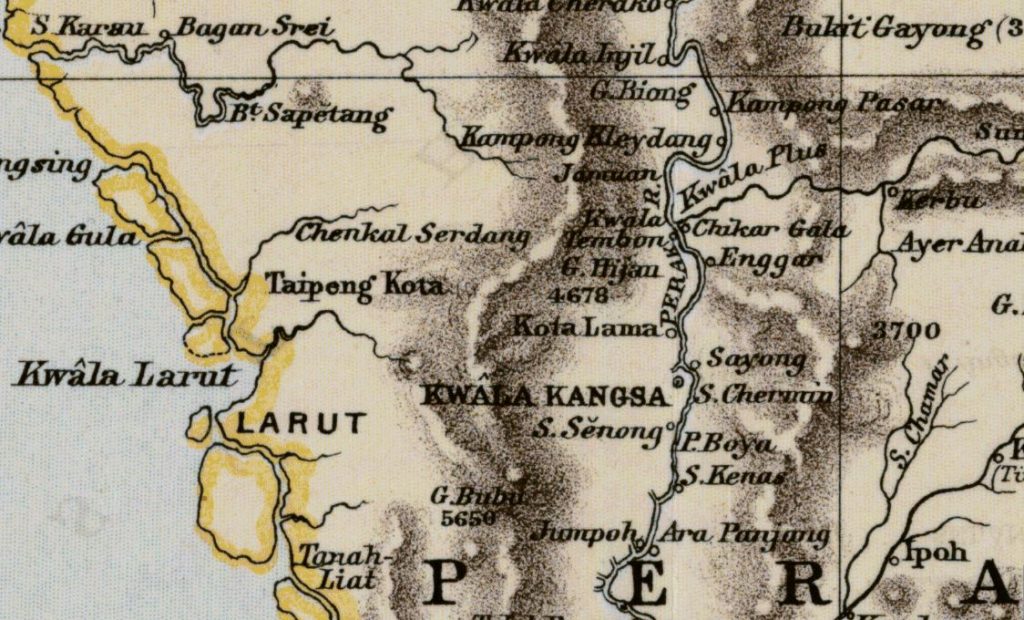
In the early morning of 14 February: “We had bananas and chocolate, and just at daybreak walked down the hill, where I got into a little trap drawn by a fiery little Sumatra pony, and driven by Mr. Gibbons, a worthy Australian miner who is here road-making, and was taken five miles to a place where the road becomes a quagmire not to be crossed”. This place must have been Changkat Jering, via Air Kuning about 6 miles from the Residency.
But the telegraph line was broken, and Maxwell who had accompanied her, was unable to find other elephants. “There was nothing for it but to walk, and we tramped for four miles. I could not have done the half of it had I not had my “mountain dress” on, the identical mud-colored tweed, in which I waded through the mud of Northern Japan. ” Actually she enjoys this walk tremendously, giving a vivid description of all the flowers, shrubs and trees she finds on her path.
Finally “After walking for four miles we came upon a glorious sight at a turn of the road, a small lake behind which the mountains rise forest-covered, with a slope at their feet on which stand the cocoa-nut groves, and the beautiful Malay house of the exiled Mĕntri of Larut” Nowadays the house and the lake don’t exist anymore, only the tombs of Long Jaafar, the father of Ngah Ibrahim.
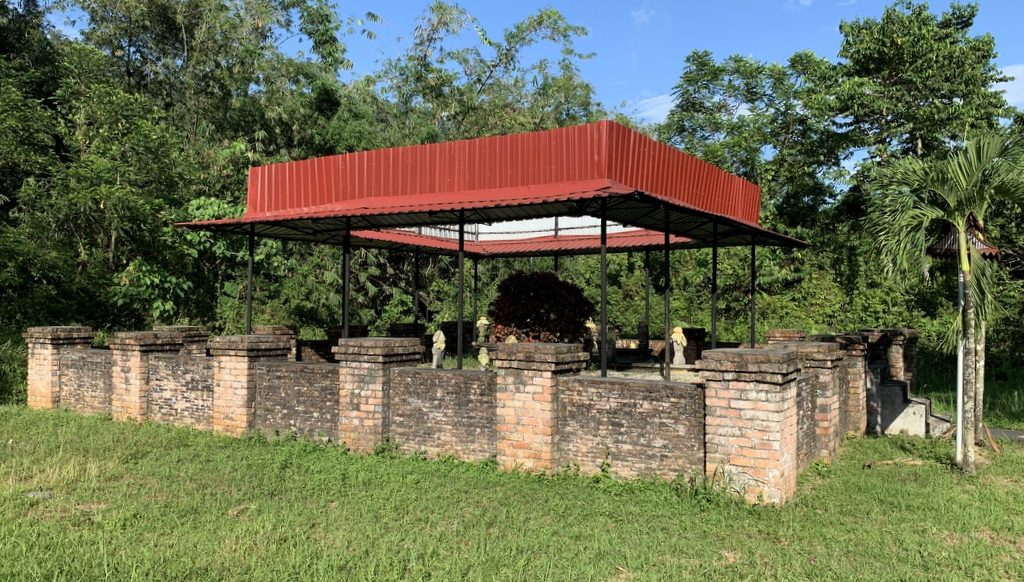
Here she waits for the elephants to arrive, while being offered cocoa-nuts, buffalo milk and lotus seeds. She writes: “Beyond is the picturesque kampong of Matang, with many good houses and a mosque. Passing through a gateway with brick posts, we entered a large walled enclosure …. “ She makes a mistake here, it is not Matang but Bukit Gantang! There is still a mosque, a porch and remains of an enclosure. Of course not necessarily the same as mentioned by her 🙂
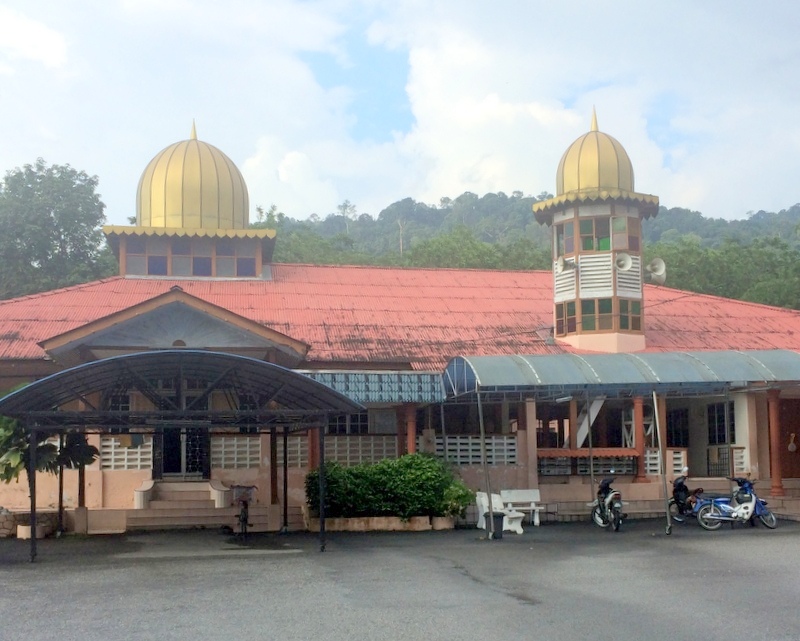
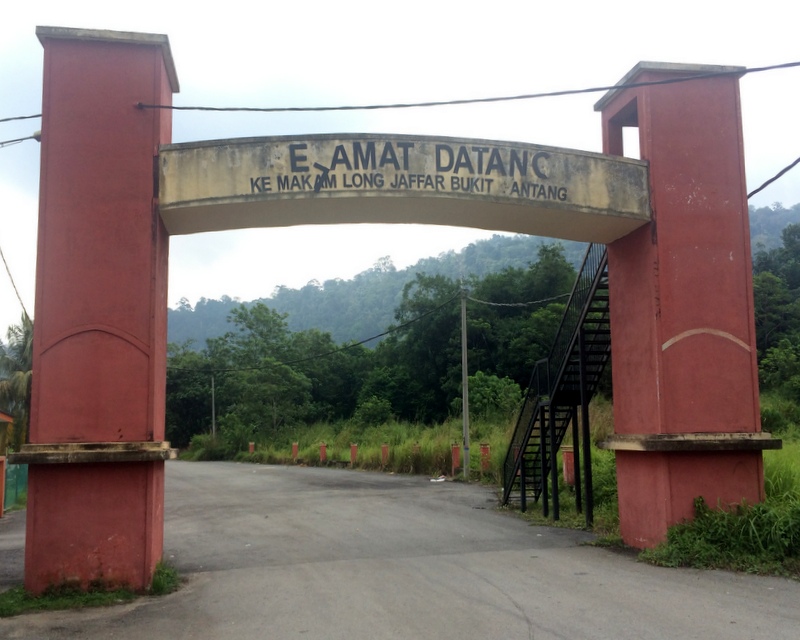
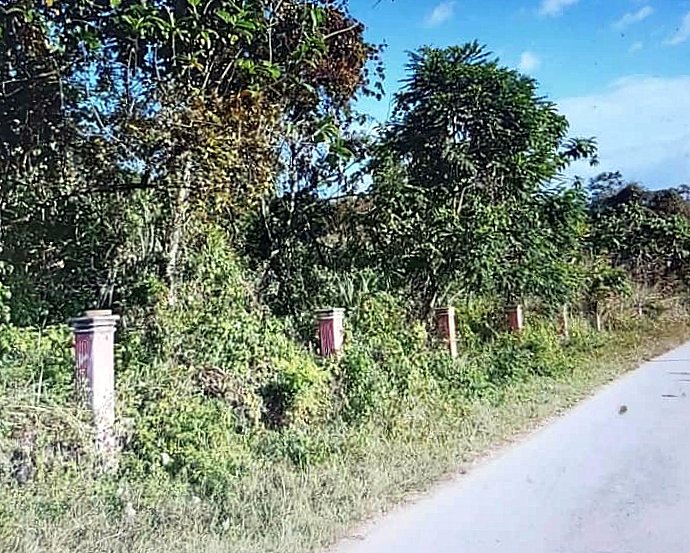
Finally her elephant arrives. The ways she describes the animal (a hideous beast) , the mounting ( I dropped into one of these baskets from the porch ), the driver ( a gossiping, careless fellow ), the riding (This mode of riding is not comfortable ), the unmounting ( letting myself down by a rattan rope upon the driver, who made a step of his back ) is so vivid and often hilarious, that I decided to combine all the passages about her elephant ride into a separate document, The first elephant ride of Isabella Bird
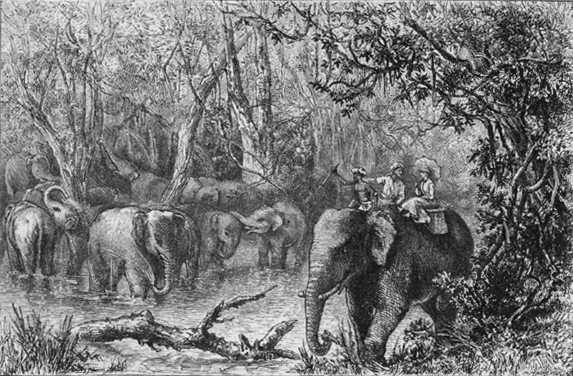
Although the ride is not comfortable, she enjoys the scenery (The pass of Bukit Berapit, seen in solitude on a glorious morning, is almost worth a journey round the world ) and the hospitality ( I clambered into a Malay dwelling of the poorer class, and was courteously received and regaled with bananas and buffalo milk) . Because the elephant is “unruly”, she walks the last few miles and has her first encounter with leeches (surprised to find that my boots were filled with blood, and on looking for the cause I found five small brown leeches, beautifully striped with yellow, firmly attached to my ankles. )
After ten hours of traveling she reaches Kuala Kangsar. “When the sun was low I looked down upon a broad and beautiful river, with hills and mountains on its farther side, a village on the shores of a promontory, and above that a grassy hill with a bungalow under cocoa-palms at its top, which I knew must be the Residency, from the scarlet uniforms at the door”.
Here is how she traveled from Taiping to Kuala Kangsar. Air Kuning and Changkat Jering are not mentioned in her book, but this seems to me the most probable route. In red the part she had to walk. The Perak river in blue
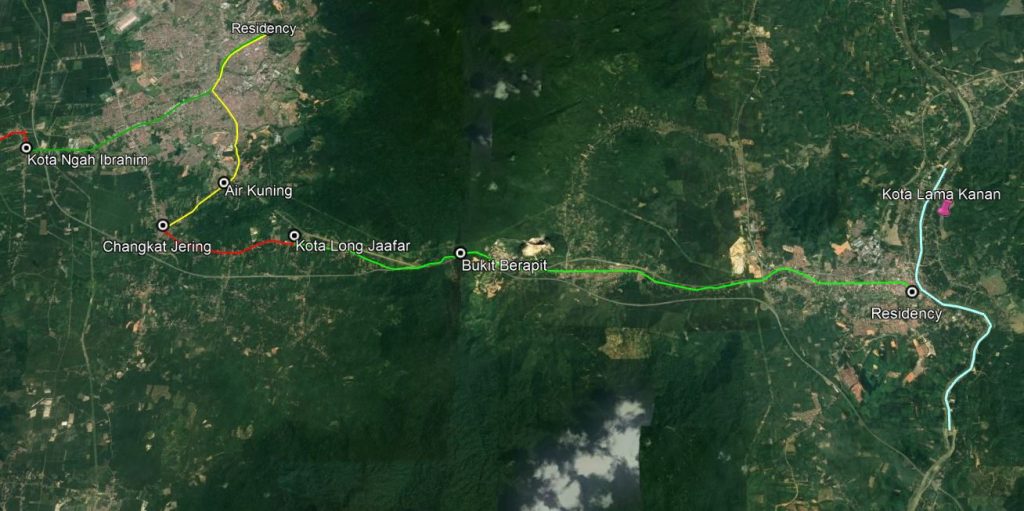
Here is her description of the Residency: …at the top of a steep slope the bungalow, which has a long flight of stairs under a latticed porch, leading to a broad and comfortably furnished veranda used as the Resident’s office and sitting-room, the centre part, which has a bed-room on each side of it and runs to the back of the house, serving for the eating-place. It is as unpretending a dwelling as can be. It keeps out the sun and rain, and gives all the comfort which is needed in this climate, but nothing more. Even simpler than the Residency in Taiping.
The Residency as described by Isabella is no more there. In 1885 Hugh Low rebuilt the Residency , there exists a picture of it. The right picture gives a view of Kuala Kangsar in the 1870s,

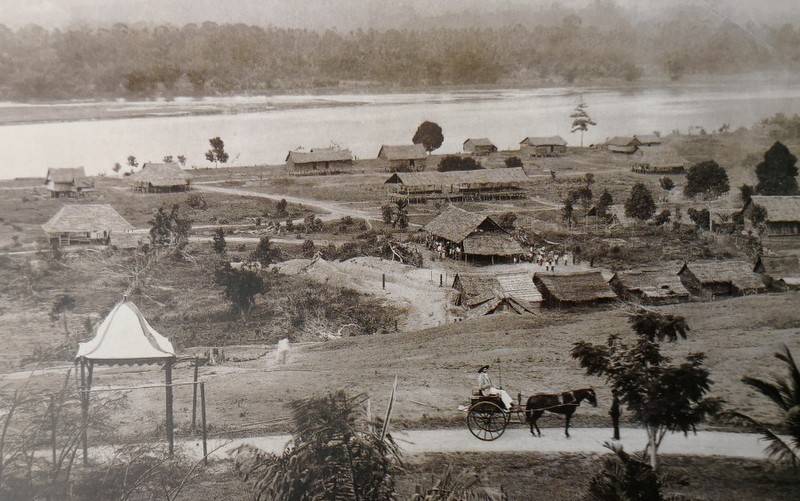
In 1905 the Residence was demolished to make place for the King’s Pavilion, accommodation for the British High Commissioner to the Federated Malay States . Now it houses a school.
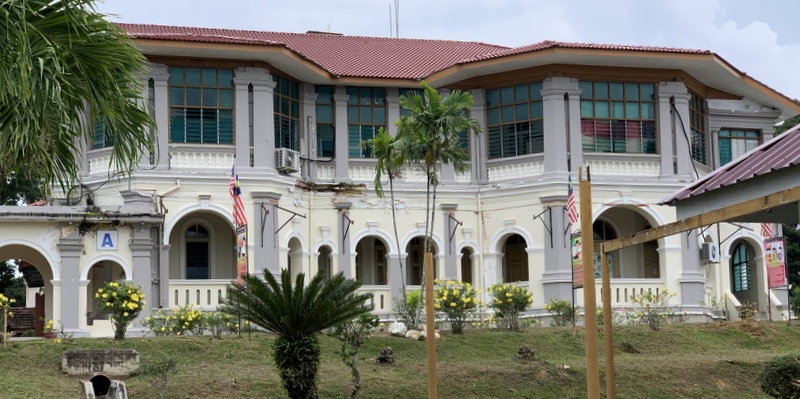
When she arrives in the Residency, she finds out that “Mr. Low, the Resident, has not returned, and I am not only alone in his bungalow in the heart of the jungle, but so far as I can learn I am the only European in the region“. She is received by the butler, has a nice bath, unfortunately her valise has not yet arrived, so she is obliged to re-dress in her mud-splashed tweed dress. She is annoyed when she sees that dinner is prepared for three, as she is not in the mood for social conversation. But it turns out that the other two guests are Mahmoud and Eblis, the two pet apes of Hugh Low!
She is fascinated by these apes and writes so often about them in her letters that I have collected these passages in a separate document Isabella Bird and the apes of Hugh Low .
On the night of her arrival, the Sinhalese clark of Hugh Low suggests that she could make a trip the following day, this time riding the Royal elephant of the Sultan. “He is such a height (they say ten feet!) that, though he lay down to be mounted, a good-sized ladder was needed for the climb upon his back”. They ride in the jungle for seven hours on the left bank of the Perak river, passing several Malay kampongs. She enjoys everything, almost intoxicated by the beauty of the flowers, the butterflies, the majestic trees. After several hours they arrive at a kampong where they dismount for lunch, “looking out from deep shadow down upon the beautiful river lying in the glory of the noonday sun, its banks bright with birds and butterflies”.
The locals tell her guide that it is possible to ford the Perak river. “The mahout said that the elephant was a “diver,” and would probably dive, but that there was no danger to us except of getting very wet” She likes the idea of crossing the river to the other side and doesn’t mind getting wet. So they go: “the elephant gently dropped down and was entirely submerged, moving majestically along, with not a bit of his huge bulk visible, the end of his proboscis far ahead, writhing and coiling like a water snake every now and then.”
After crossing the Perak river (and getting wet), Low’s clark says “”I’m going to take you to Koto-lamah; no European has been there since the war. I’ve never been there, nor the Resident either.”
The war he is talking about is the Perak war and it was in Kota Lama that the decisive battle between the British army and the warriors of Maharaja Lela took place: The Battle of Kota Lama Kanan. That was on 4 January 1876, just three years before Isabella’s visit! While crossing the river, her guide says “A few months ago they would have been firing at us from both sides of the river “
I have visited Kota Lama Kanan recently . Very peaceful and rural, difficult to imagine that a battle took place here. But at the mosque we found a cannon, the caretaker told us that it is one of the two cannons used in the battle. From the mosque you can walk down to the river. It doesn’t look very fordable here.
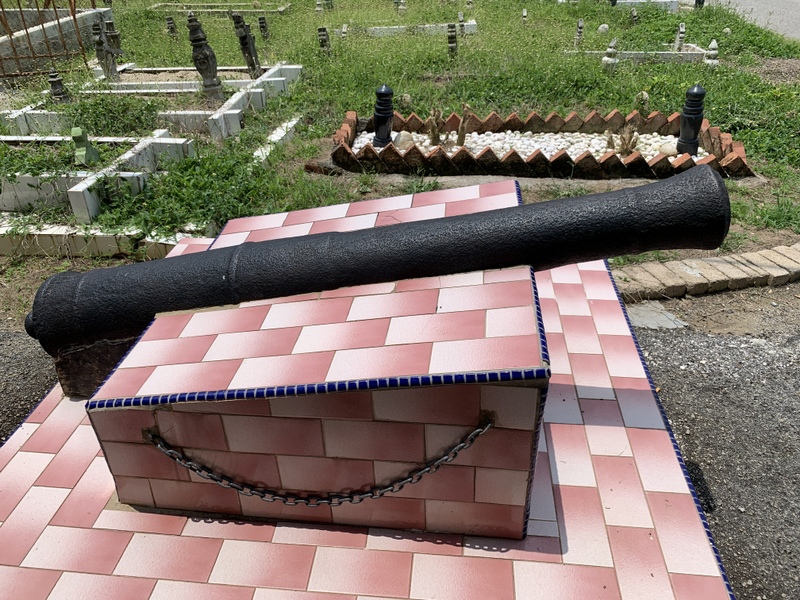
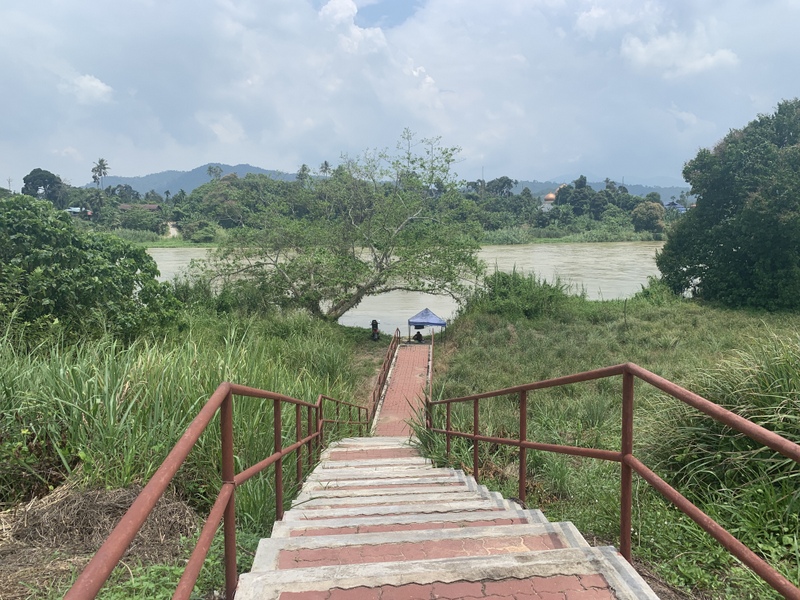
The reception of Isabella in Kota Lama Kanan is not unfriendly, although many men are armed with parangs, spears and even muskets and one of the woman she meets is the widow of Maharaja Lela! “However, though as a Briton I could not have been a welcome visitor, they sent a monkey for two cocoa-nuts, and gave me their delicious milk; and when I came away they took the entrance ladder from one of the houses to help me to mount the elephant.”
They ride back on an overgrown elephant track, passing several lairs and tiger tracks until they reach Kuala Kangsar, where they have to cross the Perak river again, this time in a dugout. Here are two illustrations from her book, a dugout and a street in Kuala Kangsar.

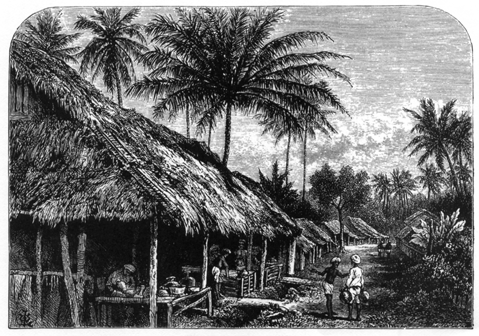
When Hugh Low hears about this adventure, he is at first displeased, saying that the clerk was ignorant and foolish, but later he admits that it has been useful to show that the region was pacified now. “..but, he added, it would appear somewhat odd that the first European to test the disposition of the Koto-lamah people should be a lady”
Her stay in Kuala Kangsar is full of variety. She meets Malay Royalty, Raja Yusuf (regent of Perak), Raja Idris (the future sultan) , the two sons of Abdullah, goes bird-shooting with Captain Walker and of course there are the apes.
So it is reluctantly that she leaves Kuala Kangsar. Hugh Low likes her company,. “Mr. Low kindly expresses regret at my going, and says he has got quite used to my being here, and added: “You never speak at the wrong time. When men are visiting me they never know when to be quiet, but bother one in the middle of business.”
Her trip back to Taiping is uneventful and much faster than when she came by elephant, one week earlier. I rode a capital pony, on Mr. Low’s English saddle, a Malay orderly on horseback escorting me, and the royal elephant carried my luggage.
She stays a few more days in Taiping before leaving for Penang, from where she sails back to England on the 25th of February.
I have concentrated in this blog on her travel adventures. The book contains a lot more, there are separate, quite informative, chapters about the states she has visited. Of course she is still a product of the Victorian era, fully convinced of the superiority of the Brits. She can be quite blunt in her opinion about the Malays and especially about the Chinese.

